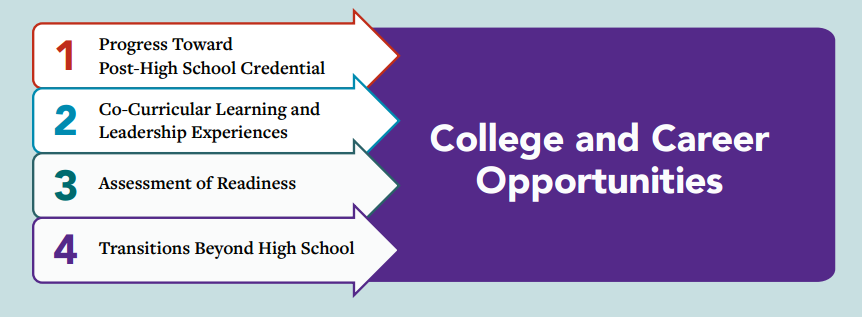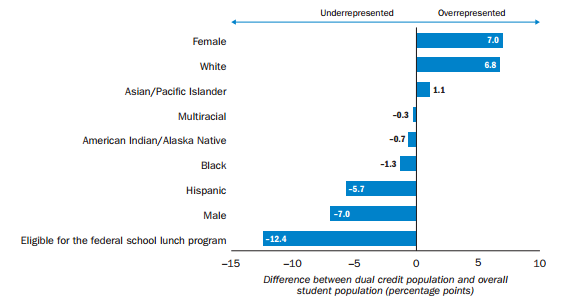 The Every Student Succeeds Act (ESSA) affords states the chance to strengthen their accountability systems by adopting multiple measures of school success rather than relying on an antiquated test-based system. Buoyed by this flexibility, state agencies across the country are exploring strategies to integrate career readiness indicators into their accountability systems. While some states have made considerable progress in this arena, others are left wondering where do we start?
The Every Student Succeeds Act (ESSA) affords states the chance to strengthen their accountability systems by adopting multiple measures of school success rather than relying on an antiquated test-based system. Buoyed by this flexibility, state agencies across the country are exploring strategies to integrate career readiness indicators into their accountability systems. While some states have made considerable progress in this arena, others are left wondering where do we start?
To help states navigate this new territory, Education Strategy Group and the Council of Chief State School Officers convened a workgroup of accountability experts and tasked them with identifying and recommending robust metrics to measure career readiness. Their recommendations, released earlier this month in a brief titled Destination Known: Valuing College AND Career Readiness in State Accountability Systems, detail four possible measures of student career readiness:
- Progress Toward Post-High School Credential
- Co-Curricular Learning and Leadership Experiences
- Assessment of Readiness
- Transitions Beyond High School
The brief further outlines strategies for measuring and valuing each of these measures, demonstrating how states can implement and gradually increase the sophistication of their measurement indicators. Lessons are also drawn from states such as Ohio, Kentucky and California that have made headway toward adopting and implementing career-focused accountability indicators in recent years.
Moving forward, JPMorgan Chase & Co. aims to support state efforts to adopt these recommendations and enhance their career-focused accountability through New Skills for Youth, a cross-state initiative to dramatically increase the number of students who graduate from high school prepared for careers.
Expanding Access to Postsecondary Learning
 Separately, students who earned dual credit in Oregon schools were more likely than their peers to graduate from high school, enroll in college and persist through their first year. That’s according to new research from the Research Education Lab at Education Northwest examining dual credit participation between 2005 and 2013. While the study reveals a correlation between dual credit attainment and positive outcomes, the authors note equity gaps in participation across student subgroups. Dual credit earners in the study were more often white, female and not on the federal free and reduced lunch program.
Separately, students who earned dual credit in Oregon schools were more likely than their peers to graduate from high school, enroll in college and persist through their first year. That’s according to new research from the Research Education Lab at Education Northwest examining dual credit participation between 2005 and 2013. While the study reveals a correlation between dual credit attainment and positive outcomes, the authors note equity gaps in participation across student subgroups. Dual credit earners in the study were more often white, female and not on the federal free and reduced lunch program.
Equitable access to higher education is not a new issue, but it can often be exacerbated by performance-based funding formulas. Without careful design, such formulas can encourage two-year and four-year colleges to be more selective with who they admit into their programs. According to the Center for Legal and Social Policy (CLASP), states should adjust their postsecondary formula weights to counteract selectivity and encourage more open access to postsecondary education.
Odds and Ends
- The Education Commission of the States published an analysis of State Longitudinal Data Systems, highlighting common approaches and challenges to instituting cross-system data sharing systems. The brief profiles successes in Connecticut, Rhode Island and Wisconsin.
- A study out of Mississippi State University exploring perceptions of CTE found that 45 percent of Mississippi residents were unable to name a single CTE program in their area. The authors put forward a series of recommendations including calling on educators to actively promote the many benefits of CTE participation, such as highlighting college-bound students, program flexibility, fast-track to careers and high-skill, high-demand job opportunities.
- Two years after the California legislature launched the Career Pathways Trust — a $500 million grant program to finance collaborative career pathways — Jobs for the Future has released a summary of common successes and challenges across different grant sites.
- A new paper from the Workforce Data Quality Campaign provides a quality assurance framework for short-term occupational training programs and makes recommendations for state and federal policymakers to strengthen such programs.
- Two reports from America’s Promise Alliance, Relationships First and Turning Points, explore the role that relationship building plays in guiding students along their career pathways. The reports — the first two in an ongoing series — highlight Cafe Momentum in Dallas, TX; Per Scholas in the Bronx, NY; Urban Alliance in Washington, D.C.; and Year Up in the Bay Area.
- A new study from the Online Learning Consortium examines six institutions in the United States that are experimenting with alternative credentialing strategies to provide flexible postsecondary learning opportunities, including digital distance learning and prior learning assessments.
Austin Estes, Policy Associate
Tags: accountability, America’s Promise Alliance, California Career Pathways Trust, career readiness, Destination Known, dual credit, dual enrollment, Education Commission of the States, ESSA, Online Learning Consortium, SLDS, Workforce Data Quality Campaign

